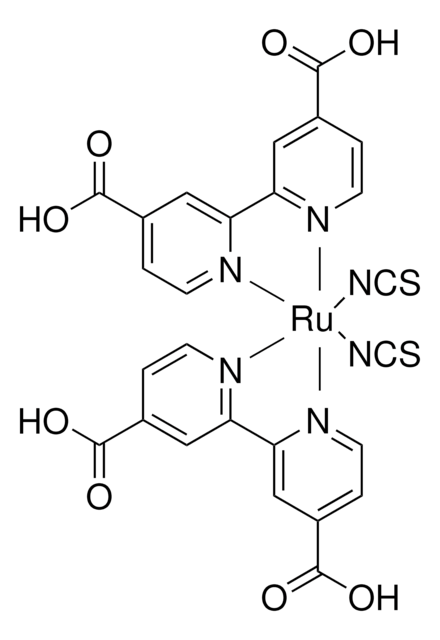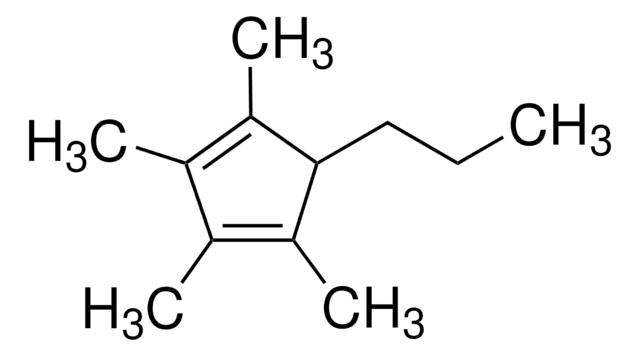Transportation information can be found in Section 14 of the product's (M)SDS.To access the shipping information for this material, use the link on the product detail page for the product.
选择尺寸
About This Item
推荐产品
品質等級
化驗
95% (NMR)
形狀
powder
成份
Dye content, ≥90% HPLC
mp
250-260 °C
λmax
534, 393, 313 nm (lit.)
SMILES 字串
S=C=N[Ru]N=C=S.CCCC[N+](CCCC)(CCCC)CCCC.CCCC[N+](CCCC)(CCCC)CCCC.OC(=O)c1ccnc(c1)-c2cc(ccn2)C([O-])=O.OC(=O)c3ccnc(c3)-c4cc(ccn4)C([O-])=O
InChI
1S/2C16H36N.2C12H8N2O4.2CNS.Ru/c2*1-5-9-13-17(14-10-6-2,15-11-7-3)16-12-8-4;2*15-11(16)7-1-3-13-9(5-7)10-6-8(12(17)18)2-4-14-10;2*2-1-3;/h2*5-16H2,1-4H3;2*1-6H,(H,15,16)(H,17,18);;;/q2*+1;;;2*-1;+2/p-2
InChI 密鑰
MQGCPZMVNHGIPF-UHFFFAOYSA-L
一般說明
應用
法律資訊
Greatcell Solar是Greatcell Solar Materials Pty Ltd的注册商标。
訊號詞
Danger
危險聲明
危險分類
Resp. Sens. 1
儲存類別代碼
11 - Combustible Solids
水污染物質分類(WGK)
WGK 3
閃點(°F)
Not applicable
閃點(°C)
Not applicable
個人防護裝備
dust mask type N95 (US), Eyeshields, Faceshields, Gloves
其他客户在看
商品
Dye-sensitized solar cells directly convert sunlight to electricity
在过去的十年中,染料敏化太阳能电池 (DSSC) 备受关注,因为此类非常规太阳能电池不仅性能出众,而且还具有低成本生产的潜力。
Dye-sensitized solar cells (DSSCs) attract attention for high performance and potential low-cost production in solar energy.
Operation principle and market dominance of single crystalline silicon solar cells.
相关内容
Optoelectronic devices such as light-emitting diodes (LEDs), solar cells, and light-emitting field effect transistors (FETs) that utilize organic materials as their light harvesting and/or charge transporting component have been the subject of much academic and commercial attention.
-
What is the Department of Transportation shipping information for this product?
1 answer-
Helpful?
-
-
What are the advantages of dye solar cells?
1 answer-
Dye solar cells (DSCs) are 3rd generation solar cells with the promise of high efficiency combined with low production costs.
Helpful?
-
-
What are the disadvantages of dye solar cells?
1 answer-
The major disadvantage to the dye solar cell design is the use of a liquid electrolyte, which has temperature stability issues. The electrolyte can freeze at low temperatures and expand at higher temperatures. It the electrolytes freezes, power production would cease, and it could potentially lead to physical damage. If the liquid expands at higher temperatures, sealing the panels would be difficult.
Helpful?
-
-
What can cause degradation of the dye solar cell?
1 answer-
Dye solar cells degrade from ultraviolet radiation. For this reason, the barrier may include UV stabilizers and/or UV absorbing luminescent chromophores (which emit at longer wavelengths) and antioxidants to protect and improve the efficiency of the cell.
Helpful?
-
Active Filters
我们的科学家团队拥有各种研究领域经验,包括生命科学、材料科学、化学合成、色谱、分析及许多其他领域.
联系技术服务部门










